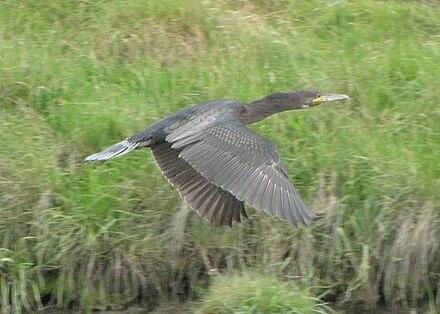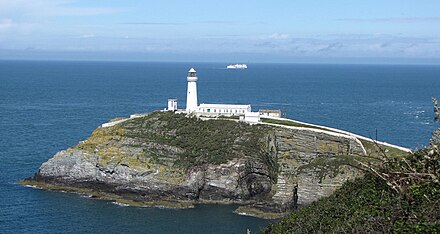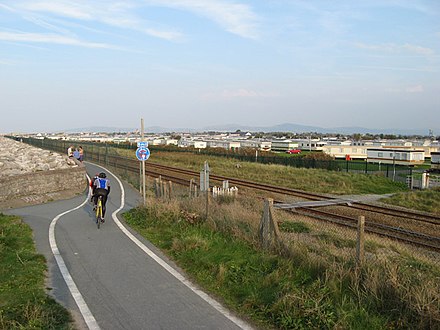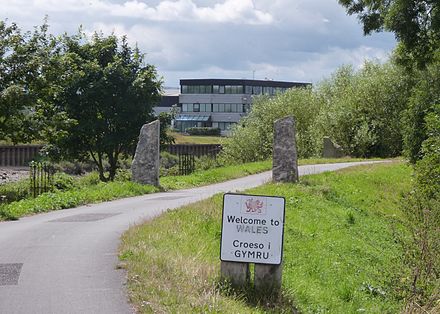Wales Coast Path - long distance footpath in Wales
Wales Coast Path (Llwybr Arfordir Cymru in Welsh) is a National Trail which follows the entire coastline of Wales, the first country in the world to have such a trail. It officially opened in May 2012, and offers a 870-mile (1,400 km) walking route from Chepstow in the south to Queensferry (near Chester) in the north. In 2011 the path was voted by National Geographic magazine as the second-best coastal destination in the world.
Understand
This path runs through eleven nature reserves. As well as providing impressive coastal landscapes there are also a number of historic castles and bridges to see and explore along the way. The Welsh coast has over 30 beaches designated Blue Flag quality.
The whole path is accessible to walkers from the many towns and villages along the coast and, where practical, some sections are suitable for cyclists, families with pushchairs, people with restricted mobility, and horse riders. Be aware that most of the trail is really suitable only for walkers with other types of use restricted to specific sections. Plan carefully if you are thinking of using anything more than your feet.
History
The trail was formed by joining together facilities and resources from sixteen local government authorities, two national parks and the Wales Natural Resources department. Some areas already had established paths, such as the Pembrokeshire Path, the Isle of Anglesey Coastal Path and the Llŷn Coastal Path. New sections of trail joined these together to complete the entire route. It was opened on 5 May 2012
Landscape
The path takes you along some stunning cliffs and long sandy and stony beaches as well as some wide river estuaries. The path goes through two national parks, the Snowdonia National Park and the Pembrokeshire Coast National Park; as well as four Areas of Outstanding National Beauty, Clwydian Range and Dee Valley, Anglesey, Gower Peninsula, Llŷn Peninsula and ends at the edge of the Wye Valley AOAB.
Eat and drink
As many of the towns along the way are tourist destinations there is ample opportunities to sample pub lunches and fish and chips. And do not miss the chance to taste Welsh lamb. Keep an eye out for Laverbread too, which is made from seaweed.
Sleep
Check the town pages along the route listed below for hotels, bed and breakfast guest houses and caravan/camp-sites. A number of interesting places to sleep are mentioned in the itinerary below, including a couple of lighthouses converted into hotels.
Buy
This is not a destination for a shopping trip, but there are plenty of towns along the way to pick up everyday supplies; even the smallest of Welsh villages seam to have a Spar (dead link: January 2023) shop. There are many craft shops to browse along the way, and plenty of seaside shops to get your bucket and spade. Probably the most practical thing to purchase would be a Welsh wool jumper or some quality woolen walking socks.

Flora and fauna
The rocky coast line and large river estuaries provides excellent birdwatching opportunities, with good chances of seeing cormorants, puffins and many waders. There are also a number of locations with the possibility of observing osprey and red kites. If you are lucky you may also see bottlenose dolphins, otters and grey seals.
Climate
For its latitude Wales has a mild climate. The winter can be a little cold and windy for hiking and at any time of the year be prepared for rain.
Prepare

There is generally a town or small village at least every 10 to 20 miles along the coast so not need for serious hiking supplies, a small rucksack with drink water and snacks should be enough for most stretches.
The route is quite convoluted in places so you are strongly advised to acquire a set of Ordnance Survey maps covering each section of the path you intend to hike. Due to the trail being built from a number of paths the way markers vary along the way.
When planning places to stay, check with the hotels if they are prepare to transfer your luggage from the previous or to the next hotel. There are also a number of companies that provide luggage transfer (dead link: January 2023) services.
Get in


.jpg/440px-Doctor_Who_Experience_(8105520673).jpg) The north trailhead is on the Chester Canal just over the English border. The southern end is at Chepstow on the banks of the River Wye.
The north trailhead is on the Chester Canal just over the English border. The southern end is at Chepstow on the banks of the River Wye.
By foot
If 870 miles is not long enough for you, a circular walk can be made by adding the Offa's Dyke Path which connects with both ends of the coastal path providing a full circle of the country.
By plane
The closest (but still a drive) main international airports are Birmingham International and Manchester Airport. Cardiff and Bristol also have some European flights while Anglesey Airport just has a domestic service to Cardiff.
By car
From England the M56 will get you to the northern end of the trail while the M4-M48 Severn Bridge will get you to the southern end.
By train
Cardiff and Swansea are on the mail line from London. Aberystwyth and some of the west coast towns can be reached from Birmingham and Shrewsbury, while the north coast towns can be reach via the North Wales Coast Line from Manchester and Crewe.
By bus
- National Express provide a service to Chester.
By boat
To Holyhead there are ferries from Dublin and Dún Laoghaire; and to Fishguard from Rosslare. A number of towns with harbours have private moorings.
Get around
The walk does not need to be done in a single expedition.
By car
There are points at convenient distances where you can park a car allowing you to use the two car one direction hiking technique. Unfortunately in the UK, even in remote locations, most parking is pay and display. This is not particular convenient for hikers as you have to make a good estimate of the time of your walk as well as indicating to car thieves the length of time you are to be gone.
By train
There are many points where trains are available.
By bike
 Since 2012, Wales Coast Path in North Wales follows part of the Reading to Holyhead National Cycle Route 5.
Since 2012, Wales Coast Path in North Wales follows part of the Reading to Holyhead National Cycle Route 5.
Walk
There are many types of accommodation along the route, including inns, B&Bs, camp-sites, hostels and self-catering facilities.
Listed below are a very small selection of things to see and do. Places to stay and where to find food are generally listed in the town articles along the way, a few that are not in villages but on the route are listing here.
Start at Welsh border to Prestatyn : 29 miles (47 km)
 Just over the border from Chester along the Dee estuary
Just over the border from Chester along the Dee estuary
Wales/England border, 53.183195°, -2.920433°. Chester/Flintshire border
Blue Bridge, Queensferry, 53.210363°, -3.017015°.
- Shotton
- Flint (Wales)
Flint castle, 53.251799°, -3.129957°. Ruins of 13th century castle
- Bagillt - Greenfield - Mostyn - Ffynnongroyw
Dee Estuary - Point of Ayr RSPB nature reserve, 53.352063°, -3.315518°. See in the Curlew and Oystercatcher Point of Ayr lighthouse, 53.354253°, -3.316284°. Built in 1776 at the northernmost point of mainland Wales at the mouth of the river Dee.
- Talacre Flintshire/Denbighshire border
Prestatyn to Bangor : 60 miles (97 km)
 This section also known as the North Wales Path, covers the North Wales Coast and the Dee Estuary.
This section also known as the North Wales Path, covers the North Wales Coast and the Dee Estuary.
Prestatyn central beach, 53.343583°, -3.41285°. Blue Flag beach
Start of Offa's Dyke Path, 53.342558°, -3.412501°.
Abergele beach, 53.294567°, -3.587308°. Blue Flag beach
Victoria Pier, Colwyn Bay, 53.297312°, -3.722953°. length 227m Opened 1900 Rhos on Sea beach, Colwyn Bay, 53.304313°, -3.737254°. Blue Flag beach
- Rhos-on-Sea
- Llandudno
Llandudno Pier, 53.331642°, -3.825138°. length 700m Opened 1877 Great Orme Lighthouse, 53.342276°, -3.868865°. Fortress style built in 1862, now a hotel
- Deganwy
- Llandudno Junction
Conwy bridges, 53.280701°, -3.823503°. Suspension bridge built by Thomas Telford and tubular railway bridge built by Robert Stephenson.
- Conwy As well as the castle, Plas Mawr (The Great Hall), an Elizabethan town houses is well worth a visit. The town has plenty of places to eat but non that accepts hikers with a dog.

Conwy castle, 53.280059°, -3.825713°. Medieval castle with chance to walk the ramparts to get a great view of the town and river.
- YHA Conwy, Sychnant Pass Road, 53.278661°, -3.838888°, +44 1492 593571.
- Penmaenmawr
- Llanfairfechan Conwy/Gwynedd border
Garth Pier, Bangor, 53.238664°, -4.124172°. length 460 m Opened 1896
Anglesey Coastal Path : 124 miles (200km)
 Around the Isle of Anglesey.
Around the Isle of Anglesey.
- Menai Bridge town.
- Llandegfan
Beaumaris Pier, 53.261324°, -4.090158°. length 170 m Opened 1846
- Beaumaris the town has plenty of places to eat and sleep. As well the castle, the 17th century Courthouse is worth a visit.
Beaumaris Castle, 53.264802°, -4.089711°. one of the finest examples of late 13th century and early 14th century military architecture in Europe Trwyn Du Lighthouse, 53.312935°, -4.040663°. Built 1838
- Penmon
Llanddona beach, 53.30675°, -4.147217°. Blue Flag beach
- Llanddona - Pentraeth
Red Wharf Bay (Traeth Coch), 53.305621°, -4.207853°. Bay and harbour with sandy and rocky beaches.
- Red Wharf Bay The hamlet has a couple of places to eat.
Benllech beach, 53.319595°, -4.217212°. Blue Flag beach
- Llaneilian
Amlwch lighthouse, 53.415447°, -4.333035°. tower situated on the outer pier of Amlwch harbour
- Amlwch
- Bull Bay - Llanbadrig - Cemaes
Wylfa Nuclear Power Station Cemlyn Bay and lagoon Carmel Head
Church Bay beach (Porth Swtan), 53.373344°, -4.556991°. Blue Flag beach
Stanley Embankment
Holyhead Mail Pier Light (Salt Island Lighthouse), 53.314269°, -4.619957°. Built in 1821 South Stack Lighthouse, 53.306673°, -4.699502°. Built in 1809, it stands impressively on a rocky island just off the coast. Reachable by steep steps and bridge. South Stack Cliffs RSPB reserve, 53.304352°, -4.693153°. Ellin's Tower view point ad visitors centre. Good chance of seeing Puffins, Razorbills, Guillemots, Kittiwakes, Fulmars, Peregrine and Choughs nesting on the cliffs. South Stack Cafe, 53.30516°, -4.690879°. Simple but welcoming place to get a coffee and cake.
Holyhead Mountain Hut Circles (Ty Mawr), 53.304272°, -4.686051°. Site of village dating back to Middle Stone Age, visible remains of circular Iron Age dwellings. Porth Dafarch beach, 53.287603°, -4.651276°. Blue Flag beach
- Anglesey Outdoor Centre, Porthdafarch Road, 53.293593°, -4.644302°, +44 1407 769351.
- Porth Dafarch
Trearddur Bay, 53.279251°, -4.618428°. Blue Flag beach
Valley Wetlands RSPB reserve, 53.258539°, -4.532186°. Reed-fringed lakes. Chance to see tufted ducks, pochards, shovelers, gadwalls and grebes.
Barclodiad y Gawres, 53.20703°, -4.50352°. Neolithic burial chamber
- Cribinau
- Aberffraw
- Llangadwaladr
Llanddwyn Island Lighthouse, 53.135495°, -4.415438°. Tower built in 1873 Llanddwyn beach, 53.143038°, -4.386556°. Blue Flag beach
- Newborough
- Ynys Llanddwyn
- Llanidan
Britannia Bridge, 53.21625°, -4.185833°. designed and built by Robert Stephenson
Bangor to Caernarfon : 11 miles (18km)
Menai Strait.
Menai Suspension Bridge, 53.219191°, -4.162238°. Designed by Thomas Telford, completed in 1826. Point to cross into Anglesey.
- Felinheli
Caernarfon to Porthmadog : 91 miles (146km)
 Llŷn Coastal Path
Llŷn Coastal Path
Caernarfon Castle, 53.139241°, -4.27761°. Impressive medieval castle that dominates the town and harbour. Dinas Dinlle beach, 53.084578°, -4.336663°. Blue Flag beach
- Dinas Dinlle
- Clynnog Fawr - Trefor - Morfa Nefyn - Llangwnnadl - Aberdaron
- Rhiw
- Pentowyn
Abersoch beach, 52.823817°, -4.498077°. Blue Flag beach
- Abersoch
- Llanbedrog
Marian y De beach, Pwllheli, 52.878921°, -4.427626°. Blue Flag beach
Criccieth Castle, 52.9162°, -4.232422°. Castle on headland between two beaches
.jpg/440px-Portmeirion_(1814299508).jpg)
Porthmadog to Machynlleth 69 mile (111km)
Meirionnydd.
Harlech Castle, 52.860166°, -4.109073°. medieval castle, constructed atop a spur of rock close coastal flats and sea.
- Llandanwg - Pensarn - Llanbedr - Tal y Bont
Barmouth, Abermaw beach, 52.720282°, -4.05864°. Blue Flag beach
- Barmouth
- inland Penmaenpool and Dolgellau
Barmouth Bridge, 52.717722°, -4.042951°. 900 yards (820 m) maily wooded bridge with single rail track and foot crossing of the Afon (river) Mawddach.
- Fairbourne
- Llwyngwril - Tonfannau
Tywyn beach, 52.583958°, -4.101228°. Blue Flag beach
- Tywyn
- Aberdyfi
- Pennal Gwynedd/Powys border
- Machynlleth
Machynlleth to Cardigan: 65 miles (105 km)

Ceredigion Coast Path
Cors Dyfi nature reserve, 52.568134°, -3.914012°. Dyfi osprey project Powys/Ceredigion border Ynys-hir RSPB reserve, 52.546765°, -3.945301°. Welsh oak woodland with wet grassland and saltmarshes. Visitors centre and viewing points.
- Tre r-ddol - Furnace
Dyfi Furnace, 52.538273°, -3.940316°. Restored mid 18th century charcoal fired blast furnace used for smelting iron ore. Ynyslas, 52.530582°, -4.054914°. Beach and nature reserve Borth beach, 52.488713°, -4.053061°. Blue Flag beach
- Borth
- Clarach

Aberystwyth Cliff Railway, 52.424276°, -4.082828°. Opened in 1896 a 237 m length track rising 130 m
- Aberystwyth
- inland Devil's Bridge, Ponterwyd
Royal Pier, Aberystwyth, 52.415875°, -4.087797°. length 242m Opened 1875
New Quay Harbour, 52.214424°, -4.357883°. Blue Flag beach
Llangrannog beach, 52.160257°, -4.471139°. Blue Flag beach
- Llangrannog
- Penbryn
Tresaith beach, 52.135582°, -4.517788°. Blue Flag beach
- Tresaith
Aberporth beach, 52.134331°, -4.544975°. Blue Flag beach
Cardigan to Amroth : 186 miles (299 km)
Pembrokeshire Coast Path
Cardigan/Pembrokeshire border
St. Dogmaels Abbey, 52.080587°, -4.679668°. Poppit Sands, 52.106004°, -4.696448°. Blue Flag beach
- YHA Poppit Sands, Sea View, 52.107164°, -4.713528°, +44 845 371 9037.
- Ceibwr Bay, 52.078372°, -4.760925°.
Carreg Coetan Arthur Burial Chamber, 52.018229°, -4.827242°. Neolithic burial chamber
- Newport (Pembrokeshire)
- Cwm-yr-Eglwys - Pwllgwaelod
- Fishguard
- Goodwick
Strumble Head Lighthouse, 52.029697°, -5.073808°. On St. Michael's Island just of the mainland.
Whitesands beach, St Davids, 51.894901°, -5.296079°. Blue Flag beach
Newgale beach, 51.855728°, -5.126199°. Blue Flag beach
Broad Haven North beach, 51.783692°, -5.104959°. Blue Flag beach
St. Ann's Head Lighthouse, 51.68143°, -5.173704°. Build 1841 at the entrance to the Milford Haven waterway. Dale beach, 51.707513°, -5.168704°. Blue Flag beach
Lydstep beach, 51.650673°, -4.760646°. Blue Flag beach South beach, Tenby, 51.666939°, -4.704859°. Blue Flag beach Castle beach, Tenby, 51.671357°, -4.695246°. Blue Flag beach
North beach, Tenby, 51.675562°, -4.701512°. Blue Flag beach Saundersfoot beach, 51.712087°, -4.69662°. Blue Flag beach
Coppet Hall beach, Saundersfoot, 51.716288°, -4.691856°. Blue Flag beach
Amroth beach, 51.731866°, -4.658811°. Blue Flag beach
Pembrokeshire/Carmarthenshire border
Amroth to Llanelli : 68 miles (109km)
Carmarthenshire
Pendine Sands, 51.741792°, -4.556712°.
- Laugharne
- Llansteffan
 Millennium Coastal Park
Millennium Coastal Park - Carmarthen
- Ferryside
- Kidwelly
Cefn Sidan beach, Pembrey Country Park, 51.697034°, -4.357309°. Blue Flag beach Burry Port Harbour Lighthouse, 51.677485°, -4.251165°. Built in the 1830s, restored 1996
- Burry Port
- Llanelli
- Bynea Carmarthenshire/Swansea border
Llanelli to Port Talbot : 97 miles (156 km)
 Gower Peninsula and Swansea Bay Coast Path
Gower Peninsula and Swansea Bay Coast Path
- Penclawdd
Whiteford Lighthouse, 51.652573°, -4.251076°. Cast-iron lighthouse built in 1865
- YHA Port Eynon, Old Lifeboat House, 51.545041°, -4.210321°, +44 845 371 9135.
Port Eynon beach, 51.545428°, -4.203994°. Blue Flag beach Caswell Bay, 51.568147°, -4.033231°. Blue Flag beach Langland Bay, 51.566907°, -4.007265°. Blue Flag beach Bracelet Bay, 51.566967°, -3.978297°. Blue Flag beach Mumbles Pier, 51.569868°, -3.974222°. length 255m Opened 1898
- Mumbles
- Swansea
- Port Talbot
Port Talbot Steelworks, 51.568107°, -3.768926°. One of Europe's largest steelworks, the merger of a numbe of factories dating back to 1901.
- Margam
Port Talbot to Chepstow : 109 mile (176 km)


Rest Bay, Porthcawl, 51.487904°, -3.726561°. Blue Flag beach
Trecco Bay, 51.478603°, -3.672574°. Blue Flag beach
- Newton - Candelston
Ogmore Castle, 51.480688°, -3.61177°. Remains of 12th century castle
Dunraven Bay and Park, 51.440674°, -3.603262°. Amazing rock formations below the cliffs. Nash Point Lighthouse, 51.401254°, -3.556656°. Built 1832, still active.
Cardiff Airport, 51.399366°, -3.340373°. Whitmore Bay, Barry, 51.389258°, -3.274616°. Blue Flag beach
Penarth Pier, 51.435043°, -3.166087°. length 200 m Opened 1895
West Usk Lighthouse, 51.540677°, -2.994854°. Built in 1821, now a hotel.
Newport Transporter Bridge (Pont Gludo Casnewydd), 51.570648°, -2.985762°. Built in 1906, one of only eight of this type of bridge still working in the world.
Newport Wetlands, 51.545775°, -2.961681°. RSPB reserve and visitors centre Gwent/Monmouthshire border
Chepstow Castle, 51.644235°, -2.674915°. The oldest surviving post-Roman stone fortification in Britain with the building started in 1067
Offa's Dyke Path, 51.647957°, -2.672278°. Point where the end of the Wales coast path meets Offa's Dyke path

Stay safe
Although few of the villages and towns along the route have hospitals or medical centres, fixed line telephones and mobiles are common and in any emergency you should just dial 999. Then tell the emergency operator whether you need the Fire, Police or Ambulance services.
When it's less urgent than a 999 call, contact the local police in England and Wales on 101. This number should be answered 24 hours a day, 7 days a week.
Some parts of the path run along the tops of cliffs. Be careful of undercutting erosion near the edge. Also when at sea level be aware of tide changes to avoid being cut off as the tide comes in.
There are no dangerous wild animals in the U.K. but be aware of livestock in field, some cows and bulls can get annoyed and have been known in rare cases to injure. The only plant to be careful of is the stinging nettle, which for most people is only an annoying irritant.
Don't refer to the Welsh as "English".
Connect
Mobile phone coverage is patchy in some parts of the route because of the topography, but all significant towns and most villages along the trail will have a public phone box. These phones typically accept coins but not credit or debit cards, however it is usually possible to dial toll-free numbers, and calls to emergency services (see above) are always free.
Many of the pubs and hotels will have Wi-Fi service.

Go next
Head inland:
- Offa's Dyke Path is a popular walking route through the border regions of England and Wales. The dyke itself (Clawdd Offa in Welsh) has partially disappeared in places, although in the parts where it is preserved. All of Offa’s Dyke Path follows legally defined Rights of Way for all walkers and is clearly signed with an acorn symbol. Some sections are also available for horse riders and cyclists.
- Snowdonia National Park, stunning maintain, and glacial valley landscape.
- Brecon Beacons National Park the Black Mountain as well as a vast array of moorland, forests, valleys, waterfalls, lakes, caves and gorges.
- Pennine Way 429 km (268 miles) walk running the spine of England from Edale in Derbyshire to Kirk Yetholm in the Scottish Borders
- Coast To Coast Walk a 190-mile long-distance walking trail in England which crosses the North of England from St Bees in Cumbria on the West coast to Robin Hood's Bay in North Yorkshire on the East coast. Move on to the English coast, such as the:
- Cumbria Coastal Way - from Lancashire to the Scottish border.
- South West Coast Path - 630 miles (1,014 km), running from Minehead in Somerset, along the coasts of Devon and Cornwall, to Poole Harbour in Dorset. Or explore the continental coastline
- E9 European Coast Path Portugal to Estonia.
Wales Coast Path
Timezone:MultipleCoordinates:52.39, -4.00


.jpg/440px-SolvaHarbor(Garethrees).jpg)
